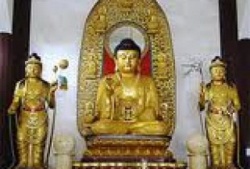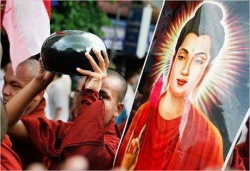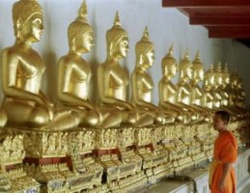The Eight Chapters of the Abhidharmakosha
The Abhidharmakosha
Introduction
There are five main branches of philosophical study in Tibetan Buddhism that are common to all schools:
1. Tsema (Buddhist epistemology)
2. The philosophy of Madyamaka (the middle way)
3. The Abhidharma (superior knowledge of phenomena)
4. Vinaya (ethics)
5. Prajnaparamita (the transcendental quality of wisdom)
With regard to these five branches, the great Indian masters wrote reference works that were elucidated through commentaries written by their principle disciples.
The original texts and their commentaries were progressively translated into Tibetan.
Tibetan masters then wrote their own commentaries in order to clarify the meaning of these reference texts from the point of view of their respective schools.
Buddhist epistemology
The objective of Buddhist epistemology is to establish a valid knowledge of phenomena.
Through the use of analysis, valid modes of knowledge are established and erroneous modes of knowledge – the source of suffering – are abandoned.
Indian sources
The study of Buddhist epistemology (Tib: tshad ma) is based on Dharmakirti’s work, the pramana-vartartikka (Tib: tshad ma rnam 'drel), a commentary on the pramana-samuccaya (Tib: tshad ma kun btus), the compendium of valid cognition by Dignaga, master of Buddhist logic.
Tibetan commentaries
The Karma Kagyu lineage uses a commentary of the pramana-vartartikka composed by the 7th Karmapa, the rig chung rgyam tshog.
The Madhyamaka philosophy
The Madhyamaka philosophy is concerned with the nature of phenomena, including both the mind that perceives and the objects perceived by this mind.
Indian sources
The Madhyamaka philosophy was developed by Nagarjuna whose works include the Mula-Madhyamaka-karika, (Tib: dbu ma tsa ba’i shes rab).
Chandrakirti wrote two commentaries on the root text, the Madhyamaka avatara (Tib: dbu ma 'jug pa), and the Madhyamaka ravrti prasannapada (Tib: tshigs gsal ba). Because Chandrakirti’s commentaries give a clear, concise understanding of Nagarjuna’s more detailed work, they are often preferred to the original. In Tibetan Buddhism, the Madhyamaka avatara is the most frequently studied.
Tibetan commentaries
In the Karma Kagyu lineage, the 8th Karmapa composed a commentary based on the above authors’ works. The Madhyamaka alankara (Tib: dbu ma rgyan) written by Shantarakshita, an Indian master, contemporary of Guru Rinpoché, has been clarified by a widely-used recent commentary by Mipham Rinpoché.
The Abhidharma does not focus on the mode of existence of phenomena, but rather on the cause of this appearance of phenomena and the manner of manifestation. It deals with both outer, physical phenomena and those belonging to the mind.
The Abhidharmakosha: a major reference work in Tibet
The author
Vasubhandu was born in 6th century Kashmir in the region of Purusapura (Peshawar). His treatises hold an important place in Buddhist philosophy. He is one of Buddhism’s “Six Ornaments”, along with Nagarjuna, Dharmakirti, etc. He first was an adept of the Sarvastivadin school, but later wrote a commentary on the Abhidharmakosha based on the Sautrantika view: the Abhidharmakoshabhasaya. Influenced by his brother, Asanga, he eventually adopted the vision of the great vehicle.
The work
When Vasubhandu wrote the Abhidharmakosha, he called it “the exposé of the Abhidharma as taught by the Kashmiri Vaibhashikas”. His text is considered to be a resumé of the Mahavibhasa, the principal Vaibhashika treatise.
The Abhidharmakosha is based on the dissertations of Vaibhashika masters. Instead of mapping out his teachings in a systematic manner, Buddha Shakyamuni gave them in answer to questions asked by his followers. Based on this, the Indian masters wrote root texts that serve as references which present a synthesis of the Buddha’s words.
The Abhidharmakosha is divided into two sections
The Karika, “verses to be memorized”, in which the author impartially exposes the orthodox vision of the Vaibhashika school.
The Bhasya, “commentary”, comments written in prose explaining the root text verse by verse and nearly word by word. He transmits and criticizes the opinions of other schools and presents his personal theory, often quite different from the Vaibhashika view.
The text
Composed in Sanskrit, the original integral text has been lost. In the 8C it was translated into Tibetan by the Indian pandita Jinamitra and the translator Peltsek Rakshi.
(Reference: P. Cornu, dictionnaire encyclopédique du bouddhisme)
When the Abhidharma is referred to in Tibet, the text is generally understood to be the Abhidharmakosha. This reference work is studied in all the shedras (Tibetan institutes of higher learning of the Dharma), although it does not directly propound the Mahayana viewpoint.
Commentaries on the original text
The original text was the basis for a number of commentaries written by Tibetan masters, such as the commentary by the Sakya master Gorampa:
go rams pa bsod nams seng ge: kun mkhyen go bo rab 'byams pa bsod nams seng ge'i bka' 'bum kha skong , [kun mkhyen go rams pa bsod names seng ge gsum 'bum supplemental texts series], Kangra (India), Yashodhara Publications, 1996, dam pa'i chos mngon pa mdzod kyi 'grel pa gzhung don rab tu gsal ba'i ni ma, a commentary of the fundamental text of Tibetan Buddhist abhidharma, the Abhidharmakosa of Vasubandhu by mus chen rab 'byams pa thugs rje dpal bzang, 4 volumes dpe cha
In the Karma Kagyu tradition, Mikyö Dorjé, the 8th Karmapa, wrote an extensive two-volume commentary of the Abhidharmakosha:
mi bskyod rdo rje: chos mngon pa’i mdzod kyi 'grel pa rgyas par spros pa grub bde’i dpyid 'jo, 2 volumes dpe cha
Subject of the Abhidharmakosha
Abhidharmakosa (Tib: mngon pa mdzod) presents the difference between “pure” and “impure” phenomena. Phenomena defined as being contaminated (Tib:zag bcas) refer to samsara, whereas phenomena defined as being “pure” (Tib: zag med) are part of nirvana. The Tibetan word zag can also mean “to fall”, hence the Dharma is what keeps one from falling, while the mind’s veils are what leads one to fall into the lower realms.
"In this way, dharmas are impure, because they are connected to corruption, or pure, because they are free from such."
La Vallée Poussin: L'Abhidharmakosa de Vasubandhu; chapter 1
Abhi means obvious or clear, dharma here refers to phenomena. Abhidharma could be translated as “the wisdom that analyses the true nature of phenomena.”
There are two categories of phenomena that should be analysed: those belonging to samsara and those belonging to nirvana. The object of the Abhidharma is to know how samsara functions and therefore to understand how to become free of it.
The Abhidharmakosha is based on the four noble truths
The abhidharma is based on the four noble truths taught by the Buddha Shakyamuni: suffering, the cause of suffering, the cessation of suffering and the path that leads to cessation.
The Abhidharmakosha stresses the importance of definitions. “Mind” is that which is capable of knowing or perceiving. “Nirvana” is the cessation of all forms of suffering, in contrast to “samasara”.
Vasubandhu uses logic and absurdity to show us what nirvana isn’t. He illustrates this by explaining that all beings desire lasting, stable happiness. Through analytical reasoning, the Abhidharmakosha identifies what enduring happiness is not, and what the cause of such happiness is not.
The Eight Chapters of the Abhidharmakosha
The abidharmakosha is comprised of eight chapters: 1.khams: the elements that constitute the three realms
2.dbang po: the sense faculties
3.'jig rten: the world, how it appears and develops
4.las: karma
5.nyon mongs: emotional afflictions and mental veils
6.lam dang gang zag: the path and the practitioner
7.ye shes: timeless wisdom
8.snyom 'jug: the description of different states of meditative absorption
Suffering and the origin of suffering, cessation and the path are the main subject of the Abhidharmakosha:
Chapters 1 and 2 give a general explanation about samsara and nirvana. They are an introduction to understanding how samsara functions.
Chapters 3, 4 and 5 explain contaminated phenomena in detail.
Chapters 6,7 and 8 describe non contaminated phenomena.
Chapter 1: the elements (skt: dhatu; tib: khams)
The classification of phenomena into 18 elements, or dhatus, includes everything that is considered to be an object of knowledge. Dhatu means "basis" or "potential" or "seed of all things", or "element containing the potential for a relationship of cause and effect".
This chapter defines samsara. Understanding the nature of samsara leads to renunciation.
The first chapter describes the object to be analyzed, the second describes the subjet: the sense faculties.
Chapter 2: the sense faculties (skt: indriyastib; tib: dbang po)
This chapter concerns the five sense faculties (sight, hearing, smell, taste, and feeling) and the mental faculty.
A detailed explanation of how perception functions leads to an understanding of how our perception of phenomena is flawed.
These two chapters are the basis for distinguishing between samsara and nirvana. This basis will allow us to understand samsara and its origin.
Chapter 3: the world (skt: lokaprajnapti, tib: 'jig rten)
This chapter is concerned with the truth of suffering. Samsara is the result of mental obscurations and karma. The world is the basis of suffering in samsara.
In brief, in Buddhist cosmology the world is comprised of three levels of existence, called the "three realms":
The formless realm and the form realm
... are realms of pure meditative absorption, beginning with the highest: "the formless realm", then "the form realm". Beings belonging to these spheres of existence are not endowed with a physical body, per se, but dwell in a state of total meditation.
The desire realm
… is itself broken down into six sub-realms: gods, titans, humans, animals, hungry ghosts and hells.
These three realms in which beings live are termed the outer world whereas the beings themselves are called the inner world.
This chapter also describes how worlds are formed through the elements and the different ways beings can be reborn through birth from a womb, an egg or other channels.
Rebirth in the three realms
Beings who are between two lives are driven by karma to take rebirth. The text describes the process undergone in the intermediate state (tib: bar do). Beings are reborn as a function of their karma and level of awareness:
“The being who has little merit enters because he thinks, ‘the wind is blowing, the sky is raining, it is cold, it is stormy, people are making a lot of noise,’ and because he thinks that he will avoid problems in this way. He thinks he is entering into a retreat place, a shelter, a root or leaf hut, or he takes cover at the base of a tree or against a wall.
“ In the same way, the being who has much merit believes he is entering into a park, a garden, a pagoda, a pavilion; he thinks he can dwell there and depart.
“ The being who is fully aware knows that he is entering into a womb, that he resides there and then exits.”
La Vallée Poussin: L'Abhidharmakosha de Vasubandhu; Chapter 3
Chapter 4: How karma works
This chapter explains the functioning of karma (tib: las) which is the cause of suffering.
Through analytical reasoning, the l'Abhidharmakosha also refutes certain points of view, such as the existence of a creator of the universe, etc.
The origin of karma is mental obscurations.
"Who makes the variety of living beings in the world and the vessel – the world itself - that were described in the previous chapter?
No God used his intelligence to create them; the variety within the world is born of karma. The variety of the world is born of the actions of living beings."
La Vallée Poussin: L'Abhidharmakosha de Vasubandhu; Chapter 4
In order to help beings cultivate actions which lead to happiness and liberation, the Buddha taught ethical discipline:
"No one who abides by discipline can be undisciplined towards any being; it is through positive thoughts having all beings as their object that discipline is acquired."
La Vallée Poussin: L'Abhidharmakosha de Vasubandhu; Chapter 4
Chapter 5: Mental obscurations (skt: klesha, tib: nyon mongs)
Mental events and latent tendencies
To describe how mind functions, it is said that there are 84,000 mental occurrences that can be resumed into 51. The sum total of mental events is called "karmic formations or latent tendencies" (skt: samskara, tib: 'du byed).
"They condition that which is conditioned" using the Abhidharmakosha’s phraseology. Karmic formations based on past karma determine our future karma.
Our experience of the world is nothing other than a vision inherited from past lives, conditioned by karma and habitual tendencies.
"How many emotional influences are there?
Six: attachment, and thereby hostility, pride, birth, false views and doubts.
The word thereby shows that because of attachment the other five settle into their object."
La Vallée Poussin: L'Abhidharmakosha de Vasubandhu; Chapter 4
Mental obscurations
Mental obscurations arise from habitual tendencies and create karma and new latent tendencies. They are samsara’s common denominator. Suffering is based on them.
Chapters 6, 7 and 8 of the Abhidharmakosha
Now that the origin and nature of the sufferings of samsara have been identified, and its causes and effects have been understood, all that is left to do is learn how to leave it all behind. This is the focus of chapters 6, 7 and 8.
Chapter 6: Practitioners and the result of the path: the cessation of suffering
The path and its practitioners (Tib: lam dang gang zag = lam path, and gang zag = person, practitioner).
The practitioner and the path are the two objects of purification.
This chapter provides a description of realized beings and an explanation of the different degrees of realization according to the four states of noble beings. These are defined as "those who have entered the stream", "those who only return once", "those who will not return" and arhats. People who have attained these different states are liberated from samsara.
The path, or methods taught by the Buddha, is the antidote to suffering. The Abhidharmakosha provides different meditation methods that focus, for example, on body posture, on how to settle one’s mind on the breath, etc. These methods lead to the cessation of strong emotions.
" Settle the thoughts on inhaling and exhaling without effort or constraint; leave the body and the mind as is; using only the memory count from one to ten."
La Vallée Poussin: L'Abhidharmakosa de Vasubandhu, chapter 6
Chapter 7: Wisdom
The path toward liberation from suffering is none other than the quality of wisdom (Skt:Jnyanas) (Tib: ye shes).
Wisdom is developed in stages. It is expressed through different kinds of knowledge and abilities until the practitioner reaches the state of Arhat. The qualities of wisdom acquired by beings on the path to Buddhahood are described here in detail.
"The Buddha himself expressed this through these words: "If someone plants a small root of virtue in the field of merit of the Buddhas, he will have an excellent destiny at first and attain Nirvana thereafter."
La Vallée Poussin: L'Abhidharmakosha de Vasubandhu, chapter 7
Chapters 6 and 7 have given a general explanation of nirvana. The stages of purification will now be described.
Chapter 8: States of meditative concentration
This is a description of the different states of concentration named "the four dhyanas". On the basis of meditative concentrationa state of equipoise is attained. The practice of shamatha (Tib: zhi gnas) gives one-pointed stability and calmness to the mind. Once this pacification has been attained, vipashyana meditation (Tib: lhag mthong) reveals the quality of wisdom.
The different stages of meditative concentration and their characteristics are developed in this chapter.
These various forms of concentration aim at pacifying the mind and reducing the strength of emotional afflictions and suffering. Through this purification, the qualities of lovingkindness, compassion, joy and equanimity mature in the mindstream.
"Those who rejoice in the qualities of others cultivate lovingkindness quickly and easily, as opposed to those who enjoy discerning others’ shortcomings."
Abhidharmakosha: op. cit, chapter 8.
"The five subjects" of the Abhidharmakosha
The five bases of knowledge (Tib:gzhi lnga) are a classification of phenomena according to the Vaibhashika school. The Abhidharmakosha is explained through them.
1 - snang ba gzugs kyi gzhi: The first point is concerned with form; it describes how forms appear.
2 - gtso bo sems kyis gzhi : The second is about the principal mind, comprised of the six consciousnesses: seeing, hearing, smelling, tasting, tactile sensations and the mental consciousness.
3 - 'khor sems byung gi gzhi: Mental events are the reactions that follow initial perception and give rise to volition based on habitual tendencies.
The second and third points are the source of samsara ; karma is based on them, as is the emotional component of the mind which is perpetuated through various forms of conditioning.
These three points together form the basic of dualistic clinging, e.g. perception of a subject and an object.
4 - ldan min 'du byed kyi gzhi: This group includes that which belongs neither to the sphere of mind nor of mental events, for example impermanence, life, death, etc.
5 - 'dus ma byas pa'i gzhi: cessation due to discrimination, cessation not due to discrimination, and space.
The first four points concern that which is conditioned, impure or contaminated by suffering (Tib:zag bcas). The fifth refers to that which is not conditioned, pure (Tib: zag med).
These are the principal subjects of the Abhidharmakosha.








